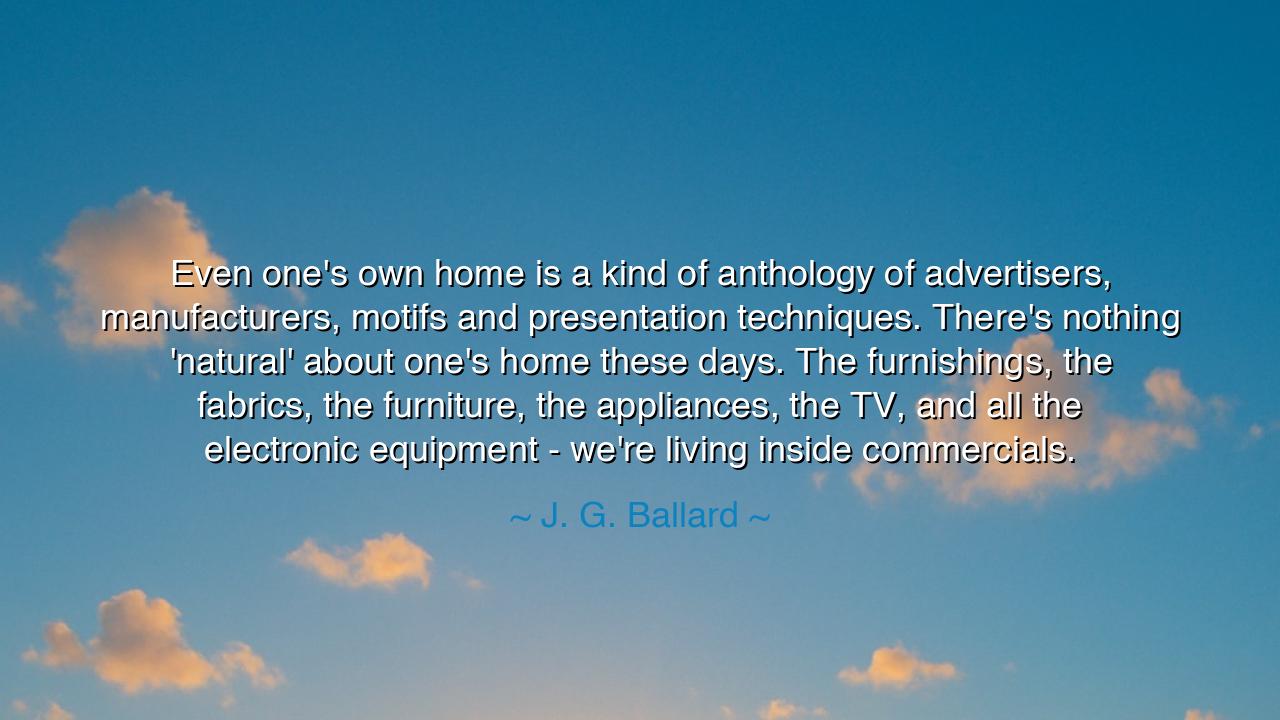
Even one's own home is a kind of anthology of advertisers
Even one's own home is a kind of anthology of advertisers, manufacturers, motifs and presentation techniques. There's nothing 'natural' about one's home these days. The furnishings, the fabrics, the furniture, the appliances, the TV, and all the electronic equipment - we're living inside commercials.






In the book of dwellings, a prophet of the modern deserts speaks: “Even one’s own home is a kind of anthology of advertisers, manufacturers, motifs and presentation techniques… There’s nothing natural about one’s home these days… the furnishings, the fabrics, the furniture, the appliances, the TV, and all the electronic equipment—we’re living inside commercials.” So declares J. G. Ballard, and his sentence tolls like a bell in a shopping mall cathedral. He would have us see that the hearth has been rehung as a showroom; that the cradle of rest is curated by invisible hands; that our chambers, once woven of memory and kin, are now bound in gloss and logo, in motifs chosen for us before we choose them.
Hear the meaning beneath the chrome. An anthology gathers many voices into one volume; so our homes collect the tongues of advertisers and manufacturers, each object a stanza singing a brand’s praise. The fabrics whisper seasonal color names; the appliances hum promises of efficiency and status; the TV and electronic equipment do not merely sit—they curate us, training our tastes, measuring our pauses. Ballard names this enchantment without malice; he only insists that we cease calling it natural. For when a thing is called natural, it is spared inquiry; when it is named manufactured, conscience awakens and begins to weigh.
Consider the origin of this enchantment. In the last century, merchants learned to sell not pots and chairs but motifs and selves. The home became a stage for presentation techniques—open-plan kitchens for performative hosting, gleaming refrigerators as altars to abundance, sofas as thrones for leisure without leisure. Advertising moved from billboards to breadboards; it ceased to invite and began to inhabit. Thus are we, as Ballard says, living inside commercials—our very pathways from bed to kettle choreographed by campaigns we did not design.
Let a historical lamp be set upon this claim. In 1959, in Moscow, the Kitchen Debate flared between Nixon and Khrushchev inside a model American kitchen. There, appliances argued louder than statesmen; a dishwasher became a syllogism, a TV a treaty, a refrigerator a prophecy. The scene revealed what Ballard later crystallized: domestic space had become a geopolitical sermon, a lacquered catechism about freedom and plenty. The home was no longer merely shelter; it was spectacle and proof, a living presentation technique.
Hear also a smaller story, from a street like your own. A family moves into a new flat and opens boxes as if they were scriptures. The router is enthroned; the TV is mounted like a sunrise; the smart speaker listens with priestly patience. A child learns the names of brands before the names of birds; a parent measures morning by notifications rather than light. Nothing monstrous occurs—only a thousand small alignments, until the home speaks in a dialect of purchase, and silence itself seems an error to be corrected by content.
What, then, is the wisdom to carry? Not flight into scorn, for we still need chairs and kettles, screens for work, circuits for warmth. Rather, it is sovereignty. If our homes are anthologies, let us become their editors. Refuse to call natural what is curated. Ask each object to justify its citizenship: Does this furniture serve rest or restlessness? Do these fabrics comfort the skin or only the gaze of guests? Does this electronic equipment free my hours or harvest them? In such questions, the house remembers it is a house, not a showroom.
Take these practices as provisions. (1) Conduct a room audit: name the advertisers speaking through each object; keep what serves, release what sells. (2) Create ad-free zones—a table without screens, a bedroom without TV—so the heart can hear itself. (3) Favor the repairable over the disposable; let manufacturers earn their place by durability, not novelty. (4) Curate motifs from memory—handed-down bowls, travel stones, children’s art—so the home bears your story, not a campaign’s. (5) Practice a weekly Sabbath of presentation: no posting, no staging, only living—bread broken, laughter unfilmed. Do these, and the house will slowly shed its costume; the commercial will dim; the hearth will glow.
Remember the prophet’s warning, and also his possibility. If we have been living inside commercials, we may yet rewrite the script. Let the home be a school of attention, where the eye learns to bless utility, the hand learns to mend, and the soul relearns quiet. Then the furnishings will become companions rather than costumes, the appliances servants rather than sovereigns, and the anthology a book whose author is known: not the market, but the family who dwells within.






AAdministratorAdministrator
Welcome, honored guests. Please leave a comment, we will respond soon